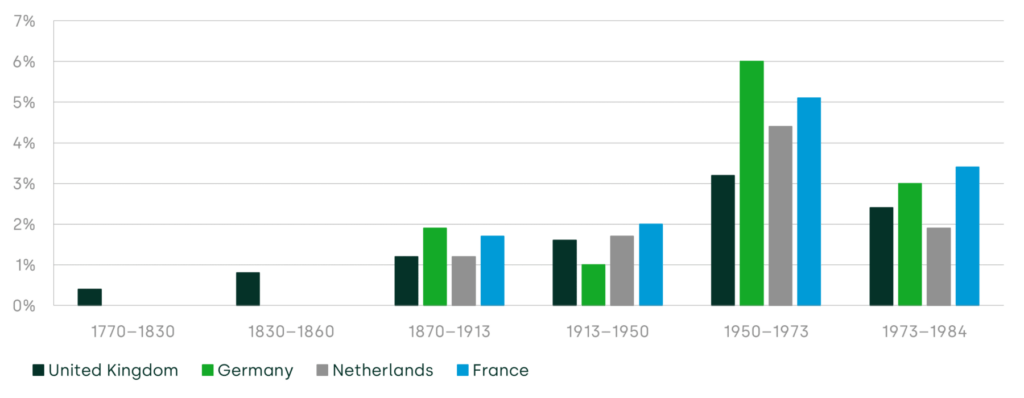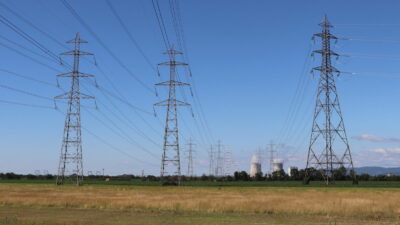Ctrl+Alt+Unemployed? The economics of AI at work
As AI continues to reshape industries and redefine the nature of work, its impact on labour markets is a topic of growing debate and concern. With AI’s rapid advancements, we are entering an era of both unprecedented opportunities and challenges. Should we fear widespread job displacement, or welcome AI’s ability to create new types of work and boost productivity?
We consider AI’s impact on labour markets through the lens of three core economic principles—capital deepening, the Jevons paradox and comparative advantage.
What can these economic principles teach us about AI? And what can we learn from historical and recent case studies of technological improvements? These questions are explored below, offering insights that can help us prepare for the future of work in an AI-driven economy.1
Core economic concepts for understanding the impact of technological advancements on labour markets
Capital deepening—AI makes human workers more efficient
When is AI a substitute for labour, and when is it a complement to it? Understanding this is central to understanding AI’s impact on the labour force.2
Investment in AI makes human workers more efficient through process improvements such as automating repetitive tasks, code-completion or more efficient matching, especially where there are significant search costs such as the job-finding process.3
History teaches us that waves of automation tend to benefit workers. The extent to which AI will be similar to these previous waves of automation remains subject to debate, including the share of jobs that will be affected.4
For example, consider the printing press—a truly transformative technology. The invention of the printing press around 1440 in Germany marked a turning point in history. Over the next 50 years, this revolutionary technology spread across Europe, transforming the way information was shared.5 The printing press was instrumental in disseminating ideas and innovations, fostering a culture of knowledge, and it greatly contributed to the accumulation of human capital.
To illustrate, literature shows that cities that adopted the printing press in the late 15th century grew 20 percentage points more in the 16th century than those that did not.6 The printing press also led to a decline in the price of books, thereby widely enhancing productivity as the cost of storing and transmitting ideas was reduced.
While there were pockets of replacement of human workers by the printing press, the overall impact on labour markets has been unambiguously positive. Lower prices for consumers led to an expansion of the market available to producers. At the same time, universities and states began competing for top talent, and eventually the printing press contributed to the creation of new jobs in, for example, journalism, entertainment magazines and books, including typesetters, paper and ink makers, writers, editors, publishers and booksellers. As a result, the labour market landscape shifted, with skilled workers contributing more effectively to work activities enhanced by—and enabled by—the printing press.7
The underlying reason for the positive impact on labour markets is capital deepening:
Capital deepening refers to the process of increasing the amount of capital per worker in an economy. This occurs when investments in capital, such as machinery, tools, as well as technology and human capital, grow at a faster rate than the labour force. As a result, each worker has more capital to work with, which can lead to increased productivity and potentially higher hourly wages.
Capital deepening is a key factor in economic growth—it enhances the efficiency and output of the labour force, contributing to overall improvements in society’s standard of living.
However, there can be significant transition challenges and costs. First, gains in productivity brought about by previous iterations of new technologies took time to materialise, which may also be the case for AI. One example is that acceleration in labour productivity growth was slow during the industrial revolution. In the UK, labour productivity grew slowly, averaging less than 0.4% per year between 1770 (around the start of the industrial revolution in the UK) and 1830. The Steam Age only materialised in the productivity statistics after 1830, with total factor productivity (TFP) growth increasing to about 0.8% per year between 1830 and 1860.8
As Figure 1 below shows, however, developed European economies experienced sustained higher productivity growth thereafter.9
Figure 1 Annual compound growth rates of labour productivity for selected European economies, 1770–1984

Source: Crafts, N. (2022), ‘Slow real wage growth during the Industrial Revolution: productivity paradox or pro-rich growth?’, Oxford Economic Papers, 74:1, pp. 1–13, for 1770–1830 in the UK; and Maddison, A. (1987), ‘Growth and slowdown in advanced capitalist economies: techniques of quantitative assessment’, Journal of economic literature, 25:2, pp. 649–698, Table 2, for 1870–1984.
Second, while many of the benefits of the industrial revolution were not immediate, some of its costs were. The available evidence indicates that in the short term, the introduction of machinery and life in factories brought about an increase in the number of injuries and deaths. For example, the New York State Compensation Commission wrote in 1910 that ‘previous to the introduction of machinery into modern industry, industrial accidents were relatively few and unimportant’, but, in the words of a safety engineer for Aetna, there had been an ‘increasing danger to life and limb involved in the pursuit of industrial occupations’.10 The number of work-related deaths and injuries in the USA showed a large decrease only at the beginning of the 20th century, reflecting efforts by labour and management to improve worker safety, as well as initiatives by state labour and health authorities and other government agencies.11
While those kinds of dire costs seem less likely in the context of the advent of AI in the workplace, other kinds of transition costs will arise. As discussed further below, technological advancements such as the internet or the personal computer took time to result in productivity improvements (the ‘productivity paradox’ discussed below). These had transition costs so that, while it has enabled remote work and global collaboration, it has also created pockets of skills gaps and disrupted some traditional industries, such as brick-and-mortar retail (to the benefit of e-commerce).
If the impact of AI turns out to be comparable, e.g. mainly acting as a substitute to labour in the short term rather than a complement, managing transition challenges effectively will be key. Given the rapid pace of change and the fact that AI is being rolled out at scale across the globe, an open question remains whether the ways in which the benefits as well as the risks of AI can be compared to earlier cycles of innovation. 12 This makes it all the more crucial to properly manage these risks to ensure that, in the longer term, human workers do reap the benefits from AI’s role as a complement to human work.13
The Jevons paradox—greater human efficiency leads to increased labour demand
Where AI complements human work, would this be expected to lead to job creation or job losses?
In the 19th century, industry used coal as a key input for production processes in many parts of the world. As machinery became more efficient, many expected that the overall use of coal would decrease—the intuition being that less coal would be needed for the same output.
In fact, the opposite proved to be the case. Because enhanced efficiency effectively made coal cheaper, it became profitable to use it as an input for additional types of production, leading to an overall increase in coal use.
This is the Jevons paradox, which states that:14
an increase in the efficiency of using a resource leads to a higher overall consumption of that resource, rather than a reduction, as the cost savings and increased availability can drive greater demand.
What this means in the context of AI is that, if AI can make human workers more efficient (through capital deepening), this makes labour more attractive, leading to greater labour demand (Jevons paradox), which should lead to increased employment and wages.
Comparative advantage—even if AI becomes better at everything, there will still be jobs for humans
But what if AI becomes more efficient at any task currently carried out by humans? In economics jargon, what happens if AI has an absolute advantage in the production of anything, i.e. it is better or faster at any task humans carry out as part of their job?
This is where the concept of comparative advantage comes in:15
Comparative advantage is the economic principle that a country, business, or individual can produce a good or service at a lower opportunity cost than others, allowing for more efficient trade and specialisation.
The theory of comparative advantage was first introduced by the British economist David Ricardo in the early 19th century, in the context of international trade. Ricardo showed that even if one country is less efficient at producing everything compared with another country, both nations can still benefit from trade. This idea became a cornerstone of classical economics and remains fundamental to our understanding of international trade today—and as discussed further below, it is also relevant in this labour market context.
The classic example goes as follows. Imagine two countries, Country A and Country B. Country A is exceptional at producing wine, using fewer resources than it would take to produce cloth. Conversely, Country B can produce cloth more efficiently than it can produce wine. According to the principle of comparative advantage, both countries can benefit by focusing on what they do best. Country A should specialise in making wine, while Country B should focus on producing cloth. Then, they can trade with each other—Country A exports wine to Country B, and Country B exports cloth to Country A. In the end, both countries end up with more wine and cloth than if they had tried to produce both goods on their own.
The same theory holds when one country is more efficient at producing everything (i.e. it has an absolute advantage)—in that case both countries are better off producing the product that they are relatively most efficient at. Consider the same example as before, but now Country A is exceptional at producing wine and producing cloth, and can do either of those more efficiently than Country B. Assume that it would take Country A one day of labour to produce a unit of wine, and one day of labour to produce a unit of cloth, whereas it would take Country B four days of labour to produce a unit of wine, and two days of labour to produce a unit of cloth. This is shown in Table 1 below.
Table 1 Illustration of comparative and absolute advantage

Source: Oxera.
Relative to Country B, Country A has a comparative advantage in the production of wine (the right-most column)—it can produce wine at equal cost to producing cloth, whereas Country B would have to incur double the cost to produce a unit of wine than the cost it would have to incur to produce a unit of cloth. In that case, it is still true that Country A should specialise in producing wine, and Country B should specialise in producing cloth, allowing both countries to trade and benefit from each other’s comparative advantage. At an ‘exchange rate’ of 1.5 units of cloth per unit of wine,16 both countries would gain from trade:
- Country A would receive 1.5 units of cloth for 1 unit of wine (which would have cost Country A 1.5 units of wine to make itself), while
- Country B only spends 1.5 units of cloth to obtain a unit of wine (which would have cost Country B 2 units of cloth to make itself).
So, even if AI becomes better at producing everything, there will still be jobs that are most efficiently carried out by humans. This is because it seems likely that, at least for the foreseeable future, there is only a finite amount of AI that could be deployed at any given point in time. AI requires compute (e.g. using computational power and resources to run algorithms or process data) each time it is used. This remains true as more compute becomes available, since at any given point in time there will be limits on compute, as the tasks for which AI is used expand.17
In the extreme utopian case where people would not need to spend any time on productive activities, this would be beneficial in the sense that it leaves them space to deploy their time and efforts in their preferred way. However, in this case, social policies will need to play a considerable role in addressing redistributive questions to ensure that standards of living are upheld.
What we can learn from more recent case studies
In 1987, Economic Sciences Nobel Laureate, Robert Solow, famously quipped that:
You can see the computer age everywhere but in the productivity statistics.
This idea came to be known as the productivity paradox. While productivity challenges remain today,18 ultimately the paradox proved temporary as more recent technological innovations have had positive impacts on economies and labour markets. This is unpacked below in the context of three key technological developments: the personal computer, the internet, and the cloud.
The personal computer
Early computers, such as those in the 1940s, were massive machines that filled entire rooms, and were used mainly for military and scientific research to perform calculations far beyond human capability. As technology advanced—in particular semiconductor technology—computers became smaller, faster, and more accessible. This led to the development of personal computers in the 1970s and 1980s, bringing personal computers into homes, schools, and small businesses for the first time. Since then, we have seen further miniaturisation and the advent of user-friendly interfaces, which democratised computing and set the stage for the digital revolution.
It is now commonly accepted that the use of computers has increased productivity in many occupations,19 and that the use of computers has led to increased wages.20
For example, Borghans and ter Weel (2005) find that there is an initial fall in demand for labour arising from computerisation, but that lower production costs result in increased demand for the product. This results in increased demand for labour and upward pressure on wages.
Similarly, Zoghi and Pabilonia (2004)21 use data from the Canadian Workplace and Employee Survey, and find that in 2000 the average wage growth for the first year of computer use is 3.8%. At the same time, workers who used a computer earned about 16.9% higher wages than those who did not.
The evidence suggests that computers have replaced human tasks, but only to a certain degree. Rather they have complemented high-skilled tasks, for example because individuals at work are able to concentrate more on those activities that constitute the essence of their profession.22 This results in higher productivity and growth for individuals as well as benefits to the wider economy.
The internet
The internet’s origins trace back to the 1960s, when the U.S. Department of Defense funded a project called ARPANET (Advanced Research Projects Agency Network) to create a communication network that could withstand a nuclear attack. ARPANET connected a number of universities and research institutions, allowing them to share data and resources. This was a radical innovation at the time, enabling remote access to information and fostering early forms of digital communication.
Since then, the internet has shifted from a niche tool to a mainstream and ubiquitous technology. Innovations such as HTML, HTTP and web browsers, as well as internet infrastructure, have made the internet user-friendly and accessible to the general public, leading to a rapid expansion of online content and services. Today, the internet is a global platform for commerce, entertainment and productivity.
The internet has also had a profound impact on labour markets. In addition to a positive link between computer use and hourly earnings, the literature considers that the internet’s facilitation of job matches, and the breaking of geographical boundaries, are major contributions to the labour market.23
For example, Bhuller et al. (2019) find that increased broadband adoption in Norway has led to a fall in recruitment costs, and a fall in the average duration of a vacancy.24 These results suggest that there was an increase in the matching efficiency, leading to an increase in wages.25
AI is increasingly playing a similar role in labour markets—it helps to alleviate classic market failures in labour markets such as search frictions, which leads to benefits to employers as well as job seekers.26 This shows that technological advancements not only benefit workers while on the job, but can also make the job-searching process more efficient overall.
Cloud adoption
Since the 2000s, cloud computing has grown into a key part of how technology is used today. It began when companies started offering the ability to rent computing power and storage over the internet, making it easier and more affordable for businesses to manage their technology needs without having to own expensive hardware. This concept quickly gained popularity, with major tech companies entering the market and expanding their cloud services.
Since then, more and more businesses adopted cloud computing because it offered flexibility, allowing them to scale their operations up or down as needed. Today, cloud computing continues to evolve, including by incorporating AI tools. As a technology that is predominantly used by businesses to augment existing human capability, there is a clear parallel between the adoption of cloud computing and that of AI.
Studies have shown that cloud computing has had a positive impact on job creation and employment.
For example, a study carried out for the European Commission’s DG CONNECT finds that, in the EU, between 300,000 and 2.5m jobs have been created by cloud computing between 2012 and 2015, and that more than 300,000 new businesses (SMEs) were expected to be created between 2015 and 2020.27
In another example, Duso and Schiersch (2022) use data on German firms and find that cloud adoption has had a significantly positive impact on labour productivity, particularly in the manufacturing and information and communication services sectors.28
Conclusion
Aggregate productivity growth (one of two main determinants of economic growth) has been notoriously low in many OECD countries since the late 1990s.29 A boost in productivity—which AI may generate—is long overdue in many economies. The case studies and core economic concepts described above present an optimistic outlook: in the long term, human workers and society stand to gain from significant advancements in AI.30
In conclusion, as we navigate the complexities of AI’s integration into the workforce, it is crucial to draw lessons from past technological revolutions while remaining adaptive to the unique challenges of today. By understanding the economic principles that guide technological change and reflecting on historical precedents, we can shape policies that mitigate the risks and maximise the benefits of AI.
Ultimately, a proactive approach—one that balances innovation with support for workers—will be key to ensuring that people can effectively put AI to work.
Footnotes
1 AI will have wider effects, such as it being an input in many new consumer products, including smartphones, wearable devices such as smartwatches, and self-driving cars. This will likely lead to new consumer demand and expanding economic output. This is also expected to have positive labour market impacts—however, this is not assessed below, as this article focuses on AI as a productivity-enhancing tool.
2 There are many different aspects and dimensions to take into account when discussing the impact of AI on labour markets. For instance, discussions about the ethics, and the risks, of AI add a certain level of uncertainty into predictions about its potential. While this article does not ignore these topics, they are not its focus.
3 Oxera (2023), ‘AI at work: benefits for the labour market’, 5 May, https://www.oxera.com/wp-content/uploads/2023/05/Oxera-AI-at-work-benefits-for-labour-markets.pdf.
4 See, for example, Acemoglu, D. (2024), ‘The Simple Macroeconomics of AI’, 5 April, Working Paper.
5 Cartwright, M. (2020), ‘The Printing Revolution in Renaissance Europe’, World History Encyclopedia, 2 November, https://www.worldhistory.org/article/1632/the-printing-revolution-in-renaissance-europe/.
6 Furthermore, those cities that experienced no prior growth advantage had a growth advantage of about 30% post 1500. See Dittmar, D.E. (2011), ‘Information technology and economic change: the impact of the printing press, The Quarterly Journal of Economics, 126:3, August, pp.1133–1172, https://people.bu.edu/chamley/764-23/Dittmar.pdf.
7 London School of Economics and Political Science (2019), ‘New media knowledge – how the printing press led to a transformation of European thought’, London School of Economics and Political Science Impact Blog, 5 May, https://blogs.lse.ac.uk/impactofsocialsciences/2019/05/05/new-media-new-knowledge/.
8 Crafts, N. (2022), ‘Slow real wage growth during the Industrial Revolution: productivity paradox or pro-rich growth?’, Oxford Economic Papers, 74:1, pp. 1-13.
9 Ibid. Crafts attributes this to (i) the impact of technological progress being uneven with large sectors being unaffected; (ii) the process of technological progress being characterised by incremental improvements and learning to realise the potential of the original inventions.
10 Aldrich, M. (1997), ‘Safety first: Technology, labor, and business in the building of American work safety, 1870-1939’, JHU Press, p. 77.
11 Centers for Disease Control and Prevention (1999), ‘Improvements in Workplace Safety – United States, 1900-1999’, 48:22, 11 June, pp. 461–69.
12 As opposed to the industrial revolution, which started off local in nature in European countries.
13 Such as geopolitical risks or risks around cyberattacks being enabled by AI.
14 Jevons, W.S. (1866), The Coal Question: An Inquiry Concerning the Progress of the Nation, and the Probable Exhaustion of Our Coal Mines, Macmilland and Co.
15 Ricardo, D. (1817), On the Principles of Political Economy and Taxation, Cambridge University Press.
16 Exchange rates between 1 and 2 would facilitate mutually beneficial trade in this instance, since those are the relative costs of wine to cloth for Country A and B respectively.
17 For the currently significant costs of generative AI, see, for example, Oremus, W. (2023), ‘AI Chatbots Lose Money Every Time You Use Them. That Is a Problem.’, The Washington
Post, 5 June, https://www.washingtonpost.com/technology/2023/06/05/chatgpt-hidden-cost-gpu-compute/.
18 See, for example, Draghi, M. (2024), ‘The future of European competitiveness: Report by Mario Draghi’, 9 September, https://commission.europa.eu/topics/eu-competitiveness/draghi-report_en.
19 Borghans, L. and ter Weel, B. (2005), ‘How computerization has changed the labour market: a review of the evidence and a new perspective’, The economics of the digital society, 219, https://core.ac.uk/download/pdf/6818648.pdf
20 See, for example, Autor, D., Krueger, A. and Katz, L. (1998), ‘Computing inequality: have
computers changed the labor market?’, Quarterly Journal of Economics, 113:4, November, pp.
1169–214; Krueger, A. (1993), ‘How computers have changed the wage structure, Quarterly Journal of Economics, February, pp. 33–60.
21 Zoghi C. and Pabilonia, S.W. (2004), ‘Which workers gain from computer use?’, Working Paper 373, U.S. Bureau of Labour Statistics, https://www.bls.gov/osmr/research-papers/2004/pdf/ec040030.pdf.
22 Borghans, L. and ter Weel, B. (2005), ‘How computerization has changed the labour market: a review of the evidence and a new perspective’, The economics of the digital society, 219, https://core.ac.uk/download/pdf/6818648.pdf
23 Freeman, R.B. (2002), ‘The labour market in the new information economy’, Working Paper 9240, National Bureau of Economic Research, https://www.nber.org/system/files/working_papers/w9254/w9254.pdf.
24 Bhuller, M., Kostol, A.R. and Vigtel, T.C. (2020), ‘How broadband internet affects labor market matching’, Working Paper 12895, IZA Discussion Papers, https://conference.iza.org/conference_files/DATA_2019/kostol_a8219.pdf.
25 For similar evidence from Germany, see Denzer, M., Schank, T. and Upward, R. (2021), ‘Does the internet increase the job finding rate? Evidence from a period of expansion in internet use’, Information Economics and Policy, 55, p. 100900, https://www.sciencedirect.com/science/article/abs/pii/S016762452030144X
26 Oxera (2023), ‘AI at work: benefits for the labour market’, 5 May, https://www.oxera.com/wp-content/uploads/2023/05/Oxera-AI-at-work-benefits-for-labour-markets.pdf.
27 European Commission (2016), ‘Measuring the impact of cloud computing in Europe: a study prepared for the European Commission DG Communications Networks, Content & Technology by Deloitte’, https://ec.europa.eu/newsroom/dae/redirection/document/41184.
28 Duso, T. and Schiersch, A. (2022), ‘Let’s switch to the cloud: cloud adoption and its effect on IT investment and productivity’, CESifo Working Paper, 9944, Center for Economic Studies and ifo Institute, https://www.econstor.eu/bitstream/10419/265979/1/cesifo1_wp9944.pdf.
29 In the Solow–Swan model, long-run economic growth is explained through population growth, and through increases in productivity, which can be driven by capital accumulation and by technological progress.
30 We have not separately assessed the current state of competition in AI-related markets in this article, but assume a sufficient degree of competition since more competitive markets are more likely to lead to more efficient outcomes.
Related

Ofgem RIIO-3 Draft Determinations
On 1 July 2025, Ofgem published its Draft Determinations (DDs) for the RIIO-3 price control for the GB electricity transmission (ET), gas distribution (GD) and gas transmission (GT) sectors for the period 2026 to 2031.1 The DDs set out the envisaged regulatory framework, including the baseline cost allowances,… Read More

Time to get real about hydrogen (and the regulatory tools to do so)
It’s ‘time for a reality check’ on the realistic prospects of progress towards the EU’s ambitious hydrogen goals, according to the European Court of Auditors’ (ECA) evaluation of the EU’s renewable hydrogen strategy.1 The same message is echoed in some recent assessments within member states, for example by… Read More

